Intel Haswell Low Power CPU Review: Core i3-4130T, i5-4570S and i7-4790S Tested
by Ian Cutress on December 11, 2014 10:00 AM ESTCPU Benchmarks
The dynamics of CPU Turbo modes, both Intel and AMD, can cause concern during environments with a variable threaded workload. There is also an added issue of the motherboard remaining consistent, depending on how the motherboard manufacturer wants to add in their own boosting technologies over the ones that Intel would prefer they used. In order to remain consistent, we implement an OS-level unique high performance mode on all the CPUs we test which should override any motherboard manufacturer performance mode.
FastStone Image Viewer 4.9
FastStone is the program I use to perform quick or bulk actions on images, such as resizing, adjusting for color and cropping. In our test we take a series of 170 images in various sizes and formats and convert them all into 640x480 .gif files, maintaining the aspect ratio. FastStone does not use multithreading for this test, and results are given in seconds.
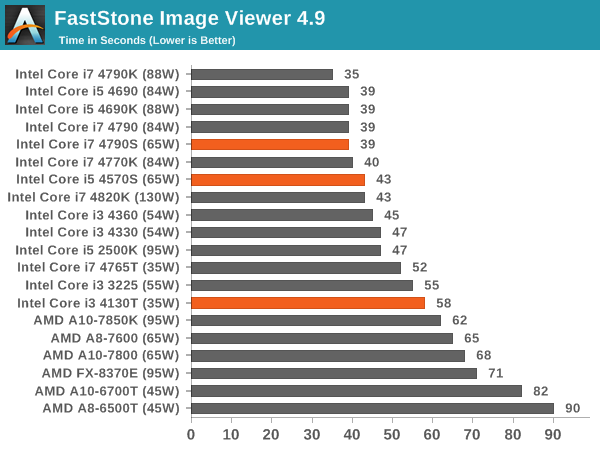
In single threaded mode these CPUs are designed to act like their non-S counterparts, except for the T which takes a bigger adjustment in the FastStone benchmark.
Dolphin Benchmark: link
Many emulators are often bound by single thread CPU performance, and general reports tended to suggest that Haswell provided a significant boost to emulator performance. This benchmark runs a Wii program that raytraces a complex 3D scene inside the Dolphin Wii emulator. Performance on this benchmark is a good proxy of the speed of Dolphin CPU emulation, which is an intensive single core task using most aspects of a CPU. Results are given in minutes, where the Wii itself scores 17.53 minutes.
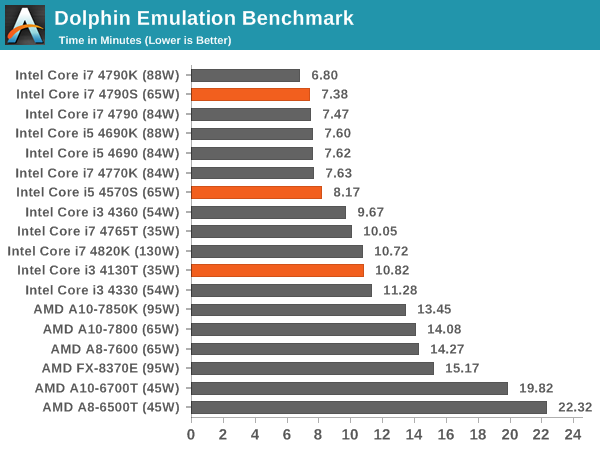
Dolphin is also single threaded, where the i7-S CPU performs on par with its non-S counterparts. The i3-T is more along the other i3 CPU we have tested.
HandBrake v0.9.9: link
For HandBrake, we take two videos (a 2h20 640x266 DVD rip and a 10min double UHD 3840x4320 animation short) and convert them to x264 format in an MP4 container. Results are given in terms of the frames per second processed, and HandBrake uses as many threads as possible.
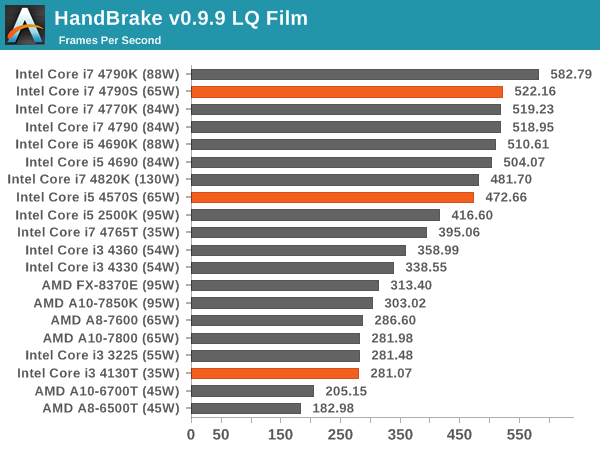
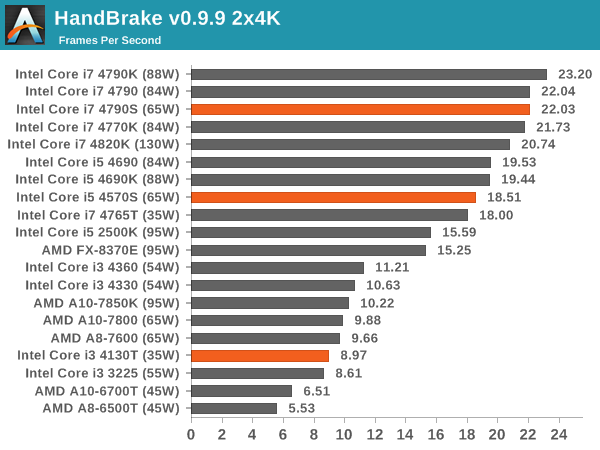
WinRAR 5.0.1: link
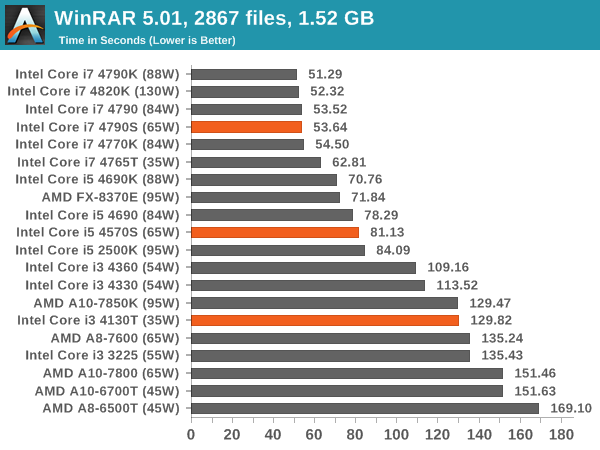
WinRAR exposes some of the variable multithreaded results, here showing the i3-T is a bit down on the non-T, but the S models are on par again.
3D Particle Movement
3DPM is a self-penned benchmark, taking basic 3D movement algorithms used in Brownian Motion simulations and testing them for speed. High floating point performance, MHz and IPC wins in the single thread version, whereas the multithread version has to handle the threads and loves more cores.

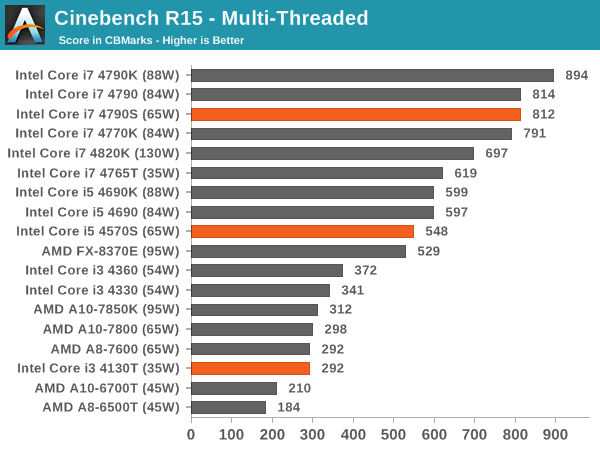
Surprisingly our i7-S CPU seems too perform as well as the non-S CPU.
Web Benchmarks
On the lower end processors, general usability is a big factor of experience, especially as we move into the HTML5 era of web browsing. For our web benchmarks, we take four well known tests with Chrome 35 as a consistent browser.
Sunspider 1.0.2
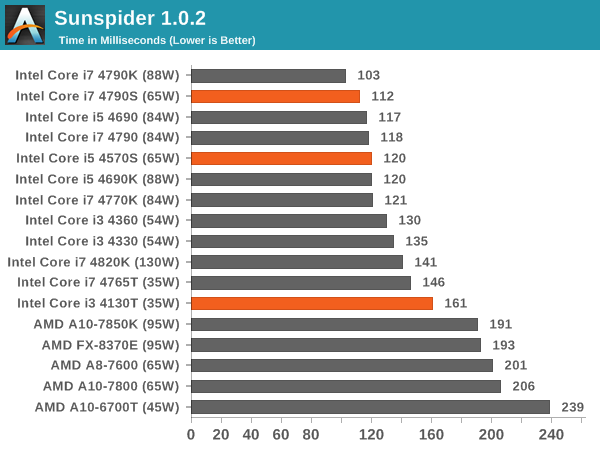
Mozilla Kraken 1.1
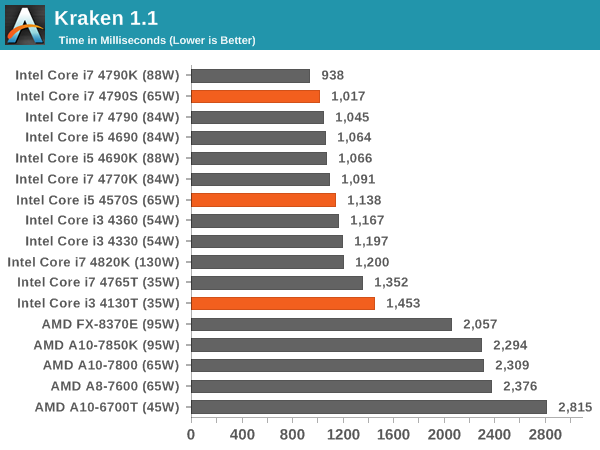
WebXPRT
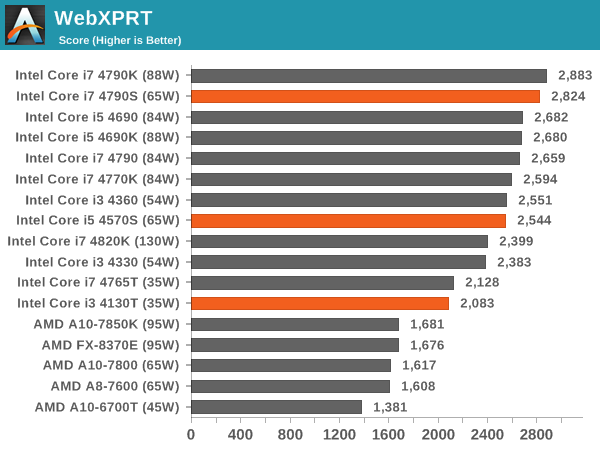
Google Octane v2
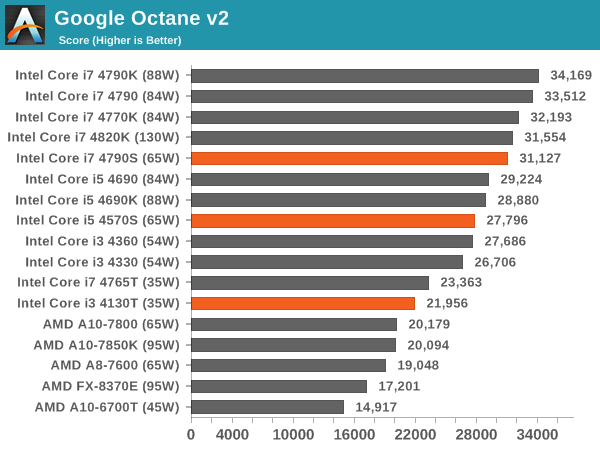










76 Comments
View All Comments
MrSpadge - Thursday, December 11, 2014 - link
> lower power cpus, saves us time from undervolting and just draws less power from day one.That's not the same. Low power CPUs limit your clock sped when you need it most, i.e. under full load. Whereas undervolting delivers full performance, or in TDP limited cases even higher performance. It does cut into the OC headroom, though.
xeizo - Thursday, December 11, 2014 - link
I expressed it badly, sorry. The point is as these cpus are TDP-limited you know how much they will draw the most, and can design cooling/case etc. based on that, and in "99%" of home user cases you don't need the extra performance of 4xfull load+OC without restraints - the cpu is fast during "normal" use. Even gaming. It's not the best buy for a pure rendering box or similar though ...xeizo - Thursday, December 11, 2014 - link
Btw, I noticed at a customer they had replaced all the workstations with mini-ITX HP:s, running 4570S and having SSD:s. They felt very snappy.azazel1024 - Thursday, December 11, 2014 - link
It would be nice to see what the idle power consumption is with like setups on some of the processors. In addition it is a shame that you have dV for power consumption for the Pentium models...but there are NO performance benchmarks for them. Both of the Haswell pentiums have roughly the same power consumption of the i3-4130t, but no idea what they actually can put up in terms of performance. Also rather suprised that the older Ivy Bridge i3 has such low power consumption, but seems to average slightly better than the i3-4130t.Too bad no test of the 4MB cache and higher clocked Hasy i3-ts. That would have been interesting, as that is almost exactly what I am thinking of replacing my G1610 server with. Though realistically by the time I get around to it, I'll probably be looking at a Broadwell based server.
piasabird - Thursday, December 11, 2014 - link
A lot of the 35 watt i3 CPU's are not available for sale anywhere. Especially the Haswell with the 4 meg cache and the 4600 graphics. One question I would pose is cant you just buy a regular i3 and just underclock it to use less power?MrSpadge - Thursday, December 11, 2014 - link
Yes. XBitLabs tested exactly that and the result is the same as the S/T models. The automatic voltage-frequency scaling of Turbo does all the magic behind the scenes (i.e. lowers the voltage when you lower the clock).sireangelus - Thursday, December 11, 2014 - link
Could we have mixed amd/intel linux test? it's very interesting to see since the compilers optimize more fairly.XZerg - Thursday, December 11, 2014 - link
Ian, man - seriously you need to stop these retarded Delta charts! They are useless! To make these even worse is that you are testing low wattage cpus. the people interested in such cpus are usually interested in idle and load numbers separately. what you have has no reference point to workout either the idle or load numbers.quit with these useless charts. there are many who have agreed to this.
sweetie peach - Thursday, December 11, 2014 - link
Agreed. Also the idle and load voltages would have been helpful.BrokenCrayons - Thursday, December 11, 2014 - link
I like the review, but I agree with this. I think readers would understand that their individual results are going to be different because they won't be running identical configurations, but we can do the simple subtraction ourselves if we want to see the difference in load versus idle. I'd much prefer getting the total system wattage at idle and load from a review. It seems more useful to me to see those raw numbers actually posted.